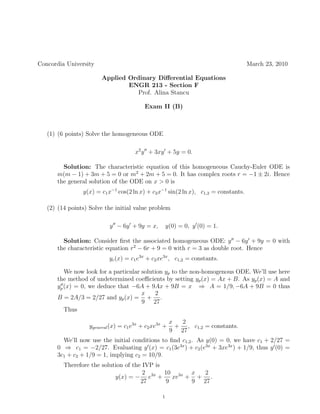
Engr 213 midterm 2b sol 2010
- 1. Concordia University March 23, 2010 Applied Ordinary Differential Equations ENGR 213 - Section F Prof. Alina Stancu Exam II (B) (1) (6 points) Solve the homogeneous ODE x2 y + 3xy + 5y = 0. Solution: The characteristic equation of this homogeneous Cauchy-Euler ODE is m(m − 1) + 3m + 5 = 0 or m2 + 2m + 5 = 0. It has complex roots r = −1 ± 2i. Hence the general solution of the ODE on x > 0 is y(x) = c1 x−1 cos(2 ln x) + c2 x−1 sin(2 ln x), c1,2 = constants. (2) (14 points) Solve the initial value problem y − 6y + 9y = x, y(0) = 0, y (0) = 1. Solution: Consider first the associated homogeneous ODE: y − 6y + 9y = 0 with the characteristic equation r2 − 6r + 9 = 0 with r = 3 as double root. Hence yc (x) = c1 e3x + c2 xe3x , c1,2 = constants. We now look for a particular solution yp to the non-homogenous ODE. We’ll use here the method of undetermined coefficients by setting yp (x) = Ax + B. As yp (x) = A and yp (x) = 0, we deduce that −6A + 9Ax + 9B = x ⇒ A = 1/9, −6A + 9B = 0 thus x 2 B = 2A/3 = 2/27 and yp (x) = + . 9 27 Thus x 2 ygeneral (x) = c1 e3x + c2 xe3x + + , c1,2 = constants. 9 27 We’ll now use the initial conditions to find c1,2 . As y(0) = 0, we have c1 + 2/27 = 0 ⇒ c1 = −2/27. Evaluating y (x) = c1 (3e3x ) + c2 (e3x + 3xe3x ) + 1/9, thus y (0) = 3c1 + c2 + 1/9 = 1, implying c2 = 10/9. Therefore the solution of the IVP is 2 10 3x x 2 y(x) = − e3x + xe + + . 27 9 9 27 1
- 2. 2 (3) (10 points) Use the variation of parameters to solve the differential equation y + y = sin2 x. Solution: The complementary part of the solution follows from r2 +1 = 0 ⇒ r = ±i and is yc (x) = c1 cos x + c2 sin x. Considering y1 (x) = cos x, y2 (x) = sin x, the Wronskian is W (x) = 1 = 0 for all real 0 sin x x’s. To find the complementary solution we calculate W1 (x) = det 2 = sin x cos x cos x 0 − sin3 x and W2 (x) = det = sin2 x cos x. − sin x sin2 x The method of variation of parameters gives yp (x) = y1 (x)u1 (x) + y2 (x)u2 (x), where u1 (x) = W1 (x)/W (x) and u2 (x) = W2 (x)/W (x). Integrating (by taking u = sin x du = cos x dx) and taking the constant of integration to be zero, we have u3 sin3 x u2 (x) = (sin2 x cos x) dx = u2 du = = . 3 3 On the other hand, u3 cos3 x u1 (x) = − sin3 x dx = − sin x (1 − cos2 x) dx = (1 − u2 ) du = u − = cos x − , 3 3 where above we used the fundamental identity of trigonometry (sin2 x + cos2 x = 1) and the substitution u = cos x, du = − sin x dx. Consequently, cos3 x sin3 x yp (x) = cos x · cos x − + sin x · 3 3 and cos4 x sin4 x y(x) = c1 cos x + c2 sin x − + cos2 x + , c1,2 = arbitrary constants. 3 3 (4) (10 points) A mass weighing 64 pounds stretches a spring 0.32 foot. Determine the equation of motion if the mass is initially released from a point 6 inches above the equilibrium position with a downward velocity of 5 ft/s. What is the instantaneous velocity at the first time when the mass passes through the equilibrium position? Solution: The equation of motion is mx + kx = 0, where m = 64/32 slug and k = 64/0.32 = 200 ft/lb. Thus x + 100x = 0 ⇒ x(t) = c1 cos 10t + c2 sin 10t, c1,2 = constants. To determine the constants, use the initial conditions. As x(0) = −1/2 ft, c1 = −1/2. Additionally, x (t) = −10c1 sin 10t + 10c2 cos 10t, thus x (0) = 5 ft/sec and 10c2 = 5.
- 3. 3 Consequently, x(t) = − 1 cos 10t + 1 sin 10t and x (t) = 5 sin 10t + 5 cos 10t. To find 2 2 the time when the mass passes through the equilibrium position, set x(t) = 0. Note that this implies tan(10t) = 1 whose first positive solution is for 10t = π/4. So √ √ 2 2 √ x (π/40) = 5 +5 = 5 2 ft/sec 2 2 is the answer needed.